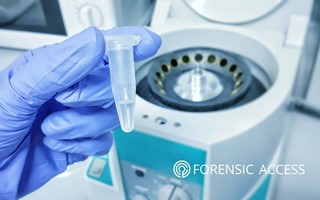News July 15, 2020 7m
Robert Green, OBE JP MA MSc. M.Litt DMS is a reader in Forensic Science and Director of Student Engagement at the University of Kent. His career in Forensic Science is extensive with a focus on technology uptake and process improvements. Highlights include developing and leading the national program of cold case rape investigation (Operation Advance), initiating performance improvements within the Home Office, and national and international projects around CCTV evidence, street crime and homicide reduction initiatives.
Here Robert discusses where the current climate of budget cuts, fragmentation and issues in the Criminal Justice System is heading.
Over my 30+ years working within the field of forensic science I've been fortunate (or perhaps unfortunate) to witness some of the ways in which forensic services are delivered. I have to say that some of this has not been for the better. For those who can still remember, the naissance of many challenges we face today can be traced, not to the closure of the Forensic Science Service and/or the emergence of the private forensic service provider. Neither can it be laid wholly at the door of austerity. I say this because a great deal of the discontinuity and flux we have seen in the delivery of forensic science was formed during times where funds were not necessarily restricted.
In this short paper, I would like to share some of my experiences and reflections over the years. For brevity, I'll focus upon just a few topics but begin by repeating my fears.
“… in the years ahead of us, the next major forensic science miscarriage of justice we are likely to see will be associated not with what is submitted to the forensic science laboratory but what is screened out”.
One can have all the quality assurance and regulation in place but if the forensic materials are screened out to begin with then who will know what may have been missed? We are wise to remember that each piece of forensic evidence collected has both inculpatory and exculpatory potential and so, screening out material that would otherwise be sent to the forensic science laboratory may very well have supported the defence.
Perhaps I can illustrate an underlying cause by saying a little about the policy of ‘best value’ (introduced in England and Wales in 1999). Although the concept has a number of objectives and outcomes, within forensic science this was often misconstrued, closing one’s eyes to quality and other features of value and denoting best value = lowest cost. Hence the emergence of screening policies and now exacerbated by austerity, ‘in house’ screening laboratories. Perhaps I can be very clear in saying that ‘best value’ should (a) never be associated with the lowest cost. Furthermore, the best value should (b) not be viewed exclusively through the eyes of the prosecution team or members of ‘case-builders’ submitting materials to support the prosecution hypothesis.
Perhaps the illustration above helps to simplify some of my remarks. Essentially, this attrition model illustrates the process from the crime scene to court. One can see (beginning on the right) the reduction between the evidence collected (discounting 100% collection as rather utopian) there are a number of steps taken prior to any submission at all. One can also see that these steps are often beyond the sight of the reviewing scientist and lawyer. There is some anecdotal evidence to suggest that because certain evidence types (for example fibres) are unlikely to be submitted, this can negatively influence those Crime Scene Examiners tasked with finding/recovering such evidence. It is sometimes said that Crime Scene Investigators are the ‘gatekeepers’ for the introduction of physical evidence into the forensics investigation process. The quality of their work will affect the outcome of the trial (Rini, USA). The diagram above illustrates these procedural weaknesses which may limit the collection of evidence at points 1-4 and those which may constrain the submission to a forensic science laboratory at 5 onwards. As things currently stand, it appears that ‘quality - regulation’ may commence, several steps along the value chain and so potentially less obvious.
Let’s now move on to a few practical ideas and suggestions. The first of these is to point you toward the photographic evidence. If evidence appears within photographs then one might enquire why it was not collected/submitted? Do you have access to the photographs (sometimes, rarely or never)? You may be well advised to go through the scene photographs as they often speak 1,000 words. Do the photographs pose any questions; most often they do? Do the photographs mirror the exhibits recovered? How many photographs are included in the ‘album’ and do you have access to any outtakes or able to gain access to these unused materials? Most importantly, do you, as a defence team appreciate and understand why certain materials were not submitted? Clearly, I’m not suggesting that everything would be examined but that all materials have been considered against the appropriate framework, referred to as case assessment and interpretation. As a defence team, are you aware of the ‘customer’ requirement (as set out in the submission form)? Are you aware of the case information and customer needs? Are you able to appreciate the decisions made on the submission, pre-assessment? For example, how was the forensic strategy formalised and how were the propositions determined? Are you able to suggest any alternative propositions? Sometimes these issues are not easily understood and would suggest that you seek support from the forensic scientist with the specialist knowledge and experience in these and other matters. They will be able to help provide a clear understanding of the case information; leading onto an agreed forensic examination strategy and defining any propositions for testing.
The next significant step in this attrition model is to consider any gap between evidence which has been collected but not submitted for screening and, most importantly between items which are submitted for (in-house) screening but not sent for laboratory testing. Due, in part to the commercial relationship between forensic science supplier and those submitting items for analysis it may not always be easy for this (investigative phase) to be fully understood. Whilst not aiming to imply that all forensic material will have value either to prosecution or defence we might be well advised to ask:
- That the forensic strategy is clearly articulated
- Why were materials, clearly visible in the photographs or otherwise collected, not progressed along the value chain?
- What reasoning underpinned any decision not to collect forensic materials?
- What rationale lay behind the decision to screen out certain items?
- In the event of any 'in-house' pre-screening, was this undertaken in a quality assured environment?
- When assessing evidence potential 'in-house', were the principles of case assessment and interpretation adhered to?
- Are there any documents to support the reasoning behind choosing materials to screen out?
- Were any of these steps conducted or advised by a scientist?
- Have you been able to access exhibit logs?
(Adapted from Major Crime Investigators Review Training Program - Green 2008 onwards).
Case Examples
Maybe a couple of examples may help by highlighting the perils associated with inappropriate screening out policies. The first example relates to an offence of rape where the intimate samples from the victim and blood samples from the suspect were submitted to the laboratory. Unusually, the victims clothing and underwear were not submitted (presumably to save on submission costs). The defendant pleaded not guilty and, not uncommonly, was remanded in custody to await trial at the Crown Court. After some time on remand, it became known to the reviewing lawyer that the victim had stated her attacker had torn her underwear. When reviewed, this underwear had been cut (and not torn) casting doubt upon the victims account and subsequently the charges were dismissed.
Another example followed the commission of a serious assault involving the use of a hammer to strike the victim. On this occasion, the submission to the laboratory consisted of a swab of blood from the hammer and a blood sample from the victim. The instructions to the lab were to obtain a DNA profile from the swab and compare with that of the victim. The scientist, on the day of the trial, was asked if the hammer had been used in the attack. Naturally, this was a very different question which was unable to be answered with the materials which had been submitted. All that could be said in the circumstances is that the DNA matched that of the victim. And so, the terms penny wise and pound foolish or, at what price justice spring to mind.
I hope that you have found these few suggestions of value. First among these is to stress the close working relationship with the scientist. This was a recurring theme and major learning point from the cold case program undertaken some years ago. In my mind and experience what this means is placing the forensic scientist as close as possible to the investigation. By adding layers, or by delegating these responsibilities to ‘in-house’ and sometimes unscientifically qualified personnel does not add to this closeness. Considering both the prosecution and defence hypotheses are a fundamental part of the way in which forensic strategies should be formed; what opportunity do you have to put forward the defence hypothesis? In closing, we ought not to underestimate the perils associated with the fallacy of incomplete evidence submission, primarily supporting the prosecution hypothesis. This is well commented upon but we would ask, rhetorically how would you know what has been ‘cherry-picked’ and what was left behind?
I hope you have found this short paper of interest. To close, may I stress that you would be well advised to question whether or not the scene was examined as you and others thought? Was the right scientific material collected and, if so was this ever submitted for scientific testing? What scientific tests were requested and what tests were actually carried out? Particularly in respect of historic ‘cold’ cases, you can perhaps consider what was scientifically possible at the time and what is possible now. I can't stress enough the value of seeking the advice of an independent, defence scientific expert. They will know what the possibilities are?
Forensic Access champion many of the points raised in Robert's article. We are accredited providers of independent and high-quality forensic services to prosecution and defence. Our forensic scientists work with our clients to delivering the work in a coordinated way as Robert describes. Speak with one of our casework management team now about your case.
To find out more about our Chemistry and Fingerprints services offered by Forensic Access fill-in our online contact form or Tel: 01235 774870 to speak with our team.


